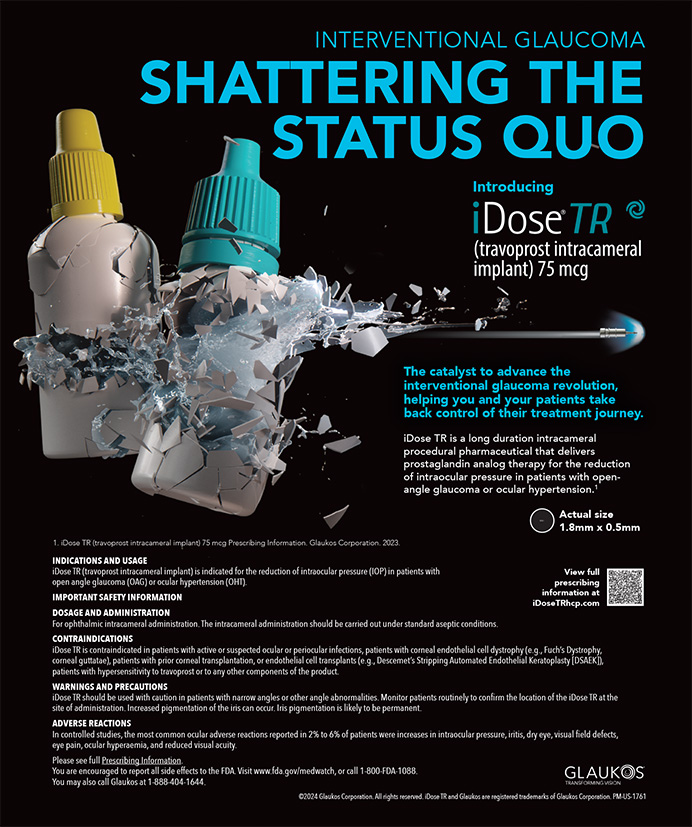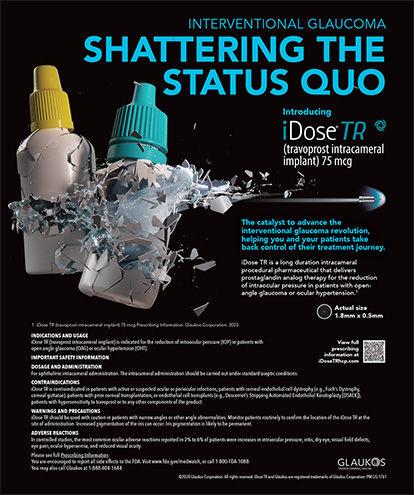A monocular patient with concurrent cataract and glaucoma and a reluctance to undergo ocular surgery not only presented a challenge. Her case also led me to significantly change my practice patterns.
THE CASE
Presentation
A 71-year-old white female presented to my office with a complaint of painless, progressive visual loss in her right eye. She was unable to read in bright light with a magnifier and had abandoned driving years ago. She still lived independently, but her family was considering placing her in a nursing home.
The BCVA of her right eye was 20/200 at distance with a refraction of 3.00 0.75 X92 and J10 at near with a 3.00 D add. Her pupil and motility and confrontation fields were normal. The IOP in her right eye was 22 mg Hg. A slit-lamp examination revealed dense nuclear and cortical lenticular opacity. She had pseudoexfoliation, and her pupil dilated to only 5 mm. There was no phacodonesis, and gonioscopy exposed an open angle with increased pigmentation. The fundus was normal on direct and indirect ophthalmoscopy except for an enlarged cup. The view on direct ophthalmoscopy was estimated at 20/200.
The patient had a well-fit ocular prosthesis in her left eye socket. The eye had been enucleated some 10 years earlier.
Her laser interferometry visual potential was 20/30 OD. To control her IOP, the patient was taking Travatan Z (Alcon Laboratories, Inc., Fort Worth, TX) at bedtime in addition to Cosopt (Merck & Co., Inc., Whitehouse Station, NJ) and Alphagan P (Allergan, Inc., Irvine, CA) twice daily. Her past medical history was significant for a combined phacoemulsification and trabeculectomy with injections of 5-fluorouracil 10 years earlier. The procedure had been complicated by early hypotony, an inadvertent bleb leak, and, eventually, endophthalmitis that had resulted in the enucleation.
The patient had been followed for years by a skilled comprehensive ophthalmologist. She also saw a glaucoma specialist, who recommended that she undergo phacoemulsification with lens implantation combined with filtering surgery in her left eye. She steadfastly refused additional surgery due to the negative outcome in her right eye.
Surgical Options
The patient and I discussed her options. I advised her that many patients, especially those with pseudoexfoliation and a narrow angle, achieve a significant reduction in IOP simply from the removal of the cataract and placement of a PCIOL. I believed this procedure was an appropriate choice for her. After consulting with her family, she elected to undergo phacoemulsification with lens implantation under topical anesthesia.
The Procedure
After stretching the pupil with Kuglen hooks, I performed phacoemulsification using a tilt-and-tumble subcapsular technique. I injected Viscoat Plus (Alcon Laboratories, Inc.) and Amvisc Plus (Bausch & Lomb, Rochester, NY) twice during the nuclear emulsification. I removed the cortex and placed a capsular tension ring. I then positioned an aspheric lens implant in the capsular bag.
The surgery was uncomplicated, and the patient saw 20/40 1 day postoperatively with mild corneal edema, flare, and cells. Her IOP was 17 mm Hg. The patient eventually achieved 20/30 UCVA and 20/20 BCVA with a manifest refraction of -0.50 0.25 X95. Her IOP stabilized at a range of 15 to 18 mm Hg on Travatan Z alone at bedtime, which allowed the patient to discontinue two of her glaucoma medications.
STUDY
This case cemented in my mind that cataract surgery with the implantation of a PCIOL effectively lowers the IOP in many patients. My colleagues and I were motivated by this patient's results and many other similar experiences to study the issue further. Thomas Samuelson, MD; Brooks Poley, MD; Richard Schulze, Sr, MD; and Richard Schulze, Jr, MD; and I decided to look more carefully at the impact of cataract surgery with PCIOL implantation on IOP.
In a retrospective review of 588 patients without glaucomatous damage and another 129 with confirmed glaucoma, we found that patients with preoperative IOP between 23 to 29 mm Hg achieved a 6- to 8-mm Hg reduction in IOP on average after cataract surgery and PCIOL implantation.1 In addition, cataract surgery with the placement of a PCIOL reduced patients' need for topical glaucoma therapy by 23 among subjects who had been taking antihypertensive medications preoperatively.
Based on the results of our review as well as our clinical experience, we now recommend cataract removal with lens implantation alone to nearly all patients who have cataract and glaucoma. We utilize a clear corneal incision, which spares the conjunctiva for future filtration or tube shunt surgery, if needed.
CONCLUSION
During the past 5 years, my use of combined phacoemulsification and trabeculectomy has fallen to nearly zero from more than 10 a decade ago. The case described herein inspired my more careful evaluation of cataract surgery alone in the glaucoma suspect and glaucoma patient. The result is a significant change in my practice pattern. I now believe that cataract surgery with PCIOL implantation may well be the best glaucoma procedure available today.
Richard L. Lindstrom, MD, is Founder and Attending Surgeon at Minnesota Eye Consultants, PA, in Bloomington. He is a paid consultant to Alcon Laboratories, Inc., and Bausch & Lomb. Dr. Lindstrom may be reached at (612) 813-3600; rllindstrom@mneye.com.


